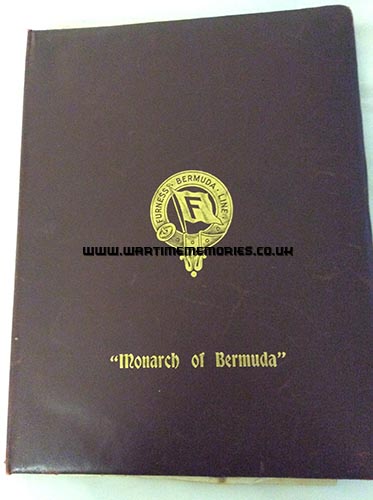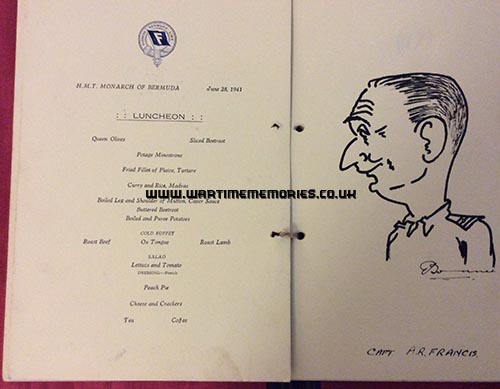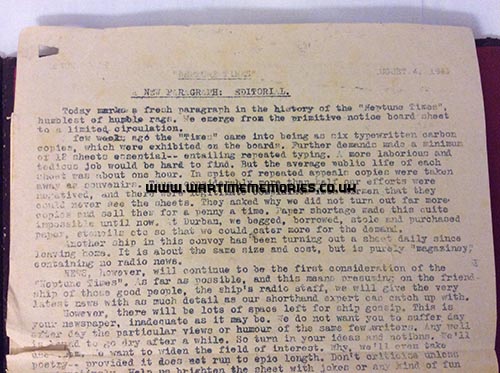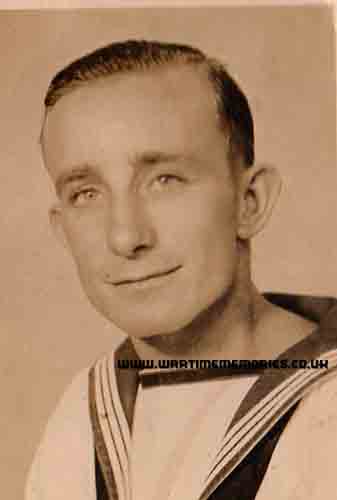The ship had arrived in Liverpool on 15th May 1941 returning from Convoy WS 5B to Suez. Dad signed on in Liverpool on 1st June as 3rd Butcher.
Embarkation of troops in Liverpool had been seriously disrupted following an explosion in Huskisson Dock on 2nd May when the Brocklebank steamer Malakand was set on fire during a raid while she was loading bombs and shells for the Middle East. Debris was scattered over acres of docks, even into Liverpool city centre and it was cleared by up to 1,300 men and 162 tipper lorries enabling the port to get back to near normal by mid June.
Monarch of Bermuda sailed for Suez with an estimated 2,200 troops on board on 28th June in company with seven other ships and escorted by the destroyers HMS Reading and Piorun (Polish). They sailed up the Irish Sea to join with the Clyde portion to form convoy WS 9B.
The convoy would have various naval escorts during the trip which would join and leave as the convoy passed their bases.
Some idea of the danger awaiting convoys is given by the following story.
The steamer Anselm had left Liverpool with Monarch of Bermuda to join convoy WS 9B but hadn’t been able to maintain the 12 knots speed. She was ordered into the Clyde and the 990 RAF and 419 troops on board were going to disembark. After a change of orders she eventually left the Clyde with escorts on 30th June. On 5th July when she was 300 miles astern of convoy WS 9B she was torpedoed by U-96 under Capt. Willenbrock.
According to a later report by the ship Cathay, the previous night’s U-Boat dispositions siutuated a submarine close to the position of Anselm and which, despite the three corvette anti-submarine screen, allowed U-96 to put in a successful attack at 05.37 when a torpe¬do struck the port side reserve bunkers of Anselm. The stokehold and engine-room were soon flooded and with the engines stopped, the ship lost way and within eight minutes, Captain Elliott reported “that Anselm was badly down by the head”. While the crew were preparing and lowering the lifeboats which were filled with personnel as they calmly filed up from the troop decks, HMS Challenger approached and skilfully placed her bow under the port quarter of Anselm, “Many men jumped on board before the two ships became separated.’ By 05.47 all remaining boats were being rapidly filled by the use of side ladders and side decks while the remaining personnel jumped into the sea to grasp the lifelines of boats and rafts. At 05.55 all the boats but one had cleared the ship, by which time “the foredeck was completely submerged and the water almost up to the level of the promenade deck. There were still some men on the after deck, but could not see if they had jumped clear before the ship sank. I myself [Captain Elliot] slid into the water short¬ly before the ship took up a vertical position stern up and then disappeared completely at 05.59.” This was 22 minutes after first being torpedoed.
Captain Elliott concluded that Anselm was abandoned without panic or unnecessary confusion. The men went to their boats in an orderly and quiet manner. Many were singing songs while the boats were being lowered. All were willing and did their best to help abandon ship quickly in the short time available.
The survivors in the water and boats were picked up by HMS Starwort and Challenger approximately 230 on the former and 820 on the latter, but owing to the intense over¬crowding an accurate count was not possible. By 08.20 both escorts were proceeding at 6 knots towing Anselm’s empty boats, but as speed increased to 13 knots these gradual¬ly broke away and were lost.
A total of 254 officers and men lost their lives in the sinking of Anselm, of which 176 were RAF, 70 from other services and 4 crew. Most of the casualties were considered to have been killed by the explosion and subsequent flooding in No. 3 hold. The troop decks in this compartment contained many RAF and RAOC and “the number of casualties was probably increased by the wooden ladders...being smashed by the explosion.” Anselm was indeed unfortunate to have been sighted and torpedoed whilst with¬in the supposed protection of an anti-submarine screen by an isolated homeward bound U-Boat. Conversely, it was fortunate that fair weather allowed the rescue of 80 per cent of the total on board.
Suffice it to say the remainder of the convoy including Monarch of Bermuda made the passage safely arriving in Freetown on 13th July to fuel and take on water and sailing on 17th July for Durban. The slower ships left the convoy at Capetown and the convoy increased speed to 14 knots rounding the Cape into a full gale which eventually turned so that they had a following sea. The swell was of considerable height and the ships became almost unmanageable and steering had to be assisted by engines.
Monarch of Bermuda arrived in Durban 30th July and carried out repairs. She left on 3rd of August with four other troop ships and three ships carrying military equipment still as part of convoy WS 9B. When they reached Aden on 15th August the convoy was disbanded.
The ship had to wait in Aden until the Monster liners Mauretania, Ile de France and Nieuw Amsterdam from convoy CM 15 had passed through ahead of her to disembark at Suez before she did. She left Aden on 21st August and arrived at Suez on 25th August
The ship left Suez on 27th August via Port Sudan to load commercial cargo at Mombasa for Capetown and the UK. The trip back to Liverpool was via Durban, Capetown, Trinidad and Halifax. At Halifax she embarked American troops to Reykjavik in Iceland and arrived back on 17th October a total journey time of three months.
The ship remained in Liverpool for five weeks during which time two weeks voyage repairs were carried out so I should imagine that Mum saw a good deal of Dad during that time.
The convoy was originally supposed to sail at the end of October 1942 as WS 13 but its designation was changed to WS 12Z (a lucky omen?). Monarch of Bermuda embarked 2,287 troops and was one of ten liners in this convoy which eventually sailed on 12th November.
The weather was initially fair but by the 16th November they were in heavy seas in a Force 8 gale which was right on the beam causing the ships to roll heavily. This caused miserable conditions throughout the overcrowded and claustrophobic troopdecks. Few if any of the troops had ever crossed the English Channel let alone been exposed to the rigours of the North Atlantic. There were no portholes, and ventilation came from the open access hatches which had to be closed at night when the ships were darkened. “Arrangements for those who succumbed to seasickness consisted of 40 gallon drums which slid about the deck with unpleasant splashings. Sanitary arrangements were, as usual, inadequate.
A man was washed overboard from one of the escorting destroyers but was not recovered. The ship Adrastus had to heave-to to secure cargo which had come adrift and didn’t catch up with the convoy until three days later.
On the 23rd November the convoy was ordered to split into slow and fast convoys. This meant that Monarch of Bermuda with eight other liners and the cruiser HMS Royal Sovereign increased speed from 13 knots to 16 knots. This enabled them to arrive at Freetown on the 25th for fuelling and water before sailing on 28th for Durban.
The passage to Durban took longer than anticipated because the route diverted to sail closer to the African coast and the convoy speed dropped to 6.1/2 knots to enable the RN escorts to rendezvous with a tanker for refuelling at Point Noire. On 13th December the weather reached gale force which repeated the heavy rolling and misery in the troopdecks experienced on the first leg of the voyage.
The convoy arrived in Durban on 18th December. By now the United States had entered the war and Japanese forces were invading Malaya. The movement control staff in Durban were receiving signals from London changing the instructions for the destinations of the various troops. As fast as they drew up new convoy plans, the instructions would change. The staff had been working 48 hours without sleep planning the convoy and then tearing up the plan and movement orders as changes took place. Unfortunately, all their hard work diverting troops and stores came to nothing because Singapore fell into Japanese hands.
Monarch of Bermuda sailed on Christmas Eve for Liverpool via Trinidad arriving back on 21st January 1942.
On 11th February Monarch of Bermuda embarked 2,500 troops and had to anchor with other troopships in the River Mersey held up by fog until the 16th. The ships formed up with the Clyde contingent for convoy WS 16 west of Orsay on the 17th. On the 18th the weather worsened to force 6 with a rough sea and short, heavy swell with poor visibility. The two Ellerman ships City of Lincoln and City of Edinburgh had to return to Liverpool and the Clyde because cargo had shifted. They subsequently sailed on convoy WS 17.
The two aircraft carriers escorting the convoy lost aircraft due to crash landings, considered by Admiral Somerville to be due to “lack of training and experience of deck landing to a regrettable degree”.
The convoy arrived in Freetown on 1st March. While in Freetown news came through that the Japanese had landed in Java and Batavia and the Dutch East Indies had surrendered which would mean no more convoys to the Far East. The troops on Monarch of Bermuda were originally destined for the Far East but would now be discharged at Durban.
When the convoy arrived at Durban on 21st March the Commodore recommended that the Armed Merchant Cruisers used for convoy protection were not suitable owing to their slow speed of 12.1/2 knots when the liners carrying 4,000 troops were capable of 18 knots or more.
Monarch of Bermuda left Durban on 24th March and returned to Liverpool via Cape Town and Freetown arriving back on 23rd April. Dad signed off the ship on 8th May.
In the eleven months on the ship Dad had spent three months in Liverpool.









